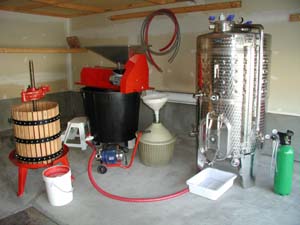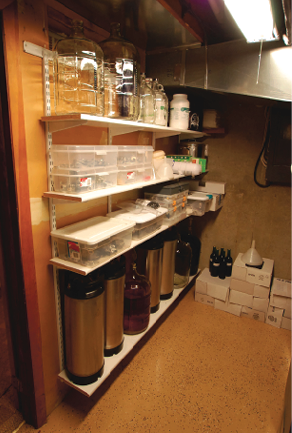 In large wineries, functional spaces are usually separated. There may be a crush pad, one or more fermentation rooms, and a cellar or cave for barrel aging. Most of us at home do not have the luxury of large dedicated spaces for our winemaking hobby. Places need to do double or even triple duty. Some hobbyists get by with very tiny spaces and yet the appeal of this hobby is so strong that they somehow make do. Today’s column will shed a little light on arrangements, tips, and techniques that may help you maximize the utility of whatever space you have.
In large wineries, functional spaces are usually separated. There may be a crush pad, one or more fermentation rooms, and a cellar or cave for barrel aging. Most of us at home do not have the luxury of large dedicated spaces for our winemaking hobby. Places need to do double or even triple duty. Some hobbyists get by with very tiny spaces and yet the appeal of this hobby is so strong that they somehow make do. Today’s column will shed a little light on arrangements, tips, and techniques that may help you maximize the utility of whatever space you have.
In his classic book (now sadly out of print) Knowing and Making Wine, Emile Peynaud cites the separation of functions as critical for a commercial winery. He notes that “wineries should be spacious and well-aired . . . vinification cannot be done properly in a confined atmosphere.” He later notes that cellar storage is just the opposite and he calls for small, closed spaces with limited airflow to control humidity and minimize temperature fluctuation. While all of this would be ideal for a home winemaker as well, it made me realize that we must often take a single space and convert its conditions as needed to the task at hand. With that in mind, I will discuss effective use of winemaking space in three broad categories: Permanent storage, year-round fermentation and cellaring, and seasonal expansion space.
Home wineries come in all shapes and sizes. To provide a reference for a limited space, I have chosen an example area of 4 feet x 8 feet (1.2 m x 2.4 m) or 32 sq. ft. (3.0 m2) — the size of a standard sheet of plywood. While it is convenient if this is in a single place — say the corner of a garage or part of a shed or outbuilding — it can be done even if the space is divided up. You might have an available closet and a little-used extra bathroom for example that could be converted to winery use. Of course, if you have more room than this, your hobby will be easier and smoother. You can scale up the volume of wine you make and also may be able to leave more things in place ready to use the next time you need them.
In my hypothetical limited space, I estimate that you can effectively make about 30 to 50 gallons (114 to 189 L) of wine every year. For reference, my actual home winery is a 13 feet x 17 feet (4 m x 5.2 m) outbuilding, or 221 sq. ft. (20.5 m2). I make between 100 and 200 gallons (379 and 757 L) each year. To make that much wine and meet the three categories of space utilization I have described, you will be taking things out and putting them away again, but you can make it work.
Permanent storage
For permanent storage, your biggest burden is winemaking equipment. A common home-size crusher/ destemmer is about 4 feet (1.2 m) long by 2 feet (0.6 m) high and wide. Fortunately, most of them can be stood up on end, so you can imagine using a corner just that big for year-round storage. A manual ratcheting basket press of a size suitable for our tiny winery takes up about the same amount of floor space. Since that is already about 1⁄4 of our total allocation, it might be better to consider an alternative (if available near your home): Renting. To process fresh grapes, you will still need the equipment, but if you can rent it from your local home winemaking supplier, you get to take it back after use and you do not need to provide the year-round storage. Other alternatives for avoiding storage of a crusher/destemmer and a press might be shared use of winemaking club equipment, partnering with a buddy who has more storage space, or using kits, concentrate, or frozen must instead of grapes. By leaving out storage of a crusher/destemmer and a press, you can instead have a cabinet or workbench of about 2 feet x 4 feet (0.6 m x 1.2 m). If you do need to store a press, you can arrange shelving above it for other storage.
The next large storage demand comes from your fermenters if you are making red wine from grapes. In a large half-ton bin, about 4 feet x 4 feet x 2 feet deep (1.2 m x 1.2 m x 0.6 m), you can ferment about 1,000 lbs (454 kg) of grapes to produce about 60 gallons (227 L) of wine. Given the constraints of our tiny winery, the long-term storage of that bin would be very inconvenient. Instead, you can use several 32-gallon (121 L) square Rubbermaid or Husky containers. Holding about 225 lbs. (102 kg) of must each, four or five of these containers can ferment as much as a half-ton bin. When finished, they nest for stacking and take up only
2 feet x 2 feet (0.6 m x 0.6 m) of floor space.
Further permanent storage may be needed for carboys, tanks, or barrels, whether full or empty. For carboys, a 6-foot x 2-foot (1.8-m x 0.6-m) chrome wire rack could fill out the rest of one side next to your fermenter stack. For empty glass or PET plastic carboys, any rack will do. If you intend to age full carboys on the same rack, check carefully on capacity. With each carboy occupying about 1 sq. ft. (0.1 m2), the larger 6.5 gal (25 L) size will load the shelf with about 65 lbs. (29 kg) of weight per square foot (316 kg/m2). Make sure the individual shelves and the complete rack are rated for that kind of load before you start. Variable capacity tanks will usually be free-standing. A 23–53 gallon (100–200 L) tank will take up about the same amount of space as the fermentation containers. (For those of you keeping track, we have now filled one of the 8-foot (2.4-m) sides with a stack of fermenters plus a 6-foot (1.8-m) rack, and now we have put a tank in another 2-foot x 2-foot (0.6-m x 0.6-m) corner. Getting crowded, but still possible!) For this scale of production a barrel may be out of the question. However, if you forego the tank, a 26- to 30-gallon (98-L to 114-L) barrel will take up just a bit more space while in use and the same amount of space when stored standing on end. So maybe not both a tank and a barrel, but one or the other is feasible.
Beyond these supplies and equipment, you will need permanent storage for racking and bottling supplies. Mostly those things can fit on the same rack as your carboys, the exception being a floor corker. If that proves too challenging, you may want to turn again to rental supplies since the use is infrequent and brief. You will also need to store testing supplies and winemaking chemicals. A cabinet or bureau may fit under your wire rack, or you may be able to file everything in plastic tubs stacked on the rack. When it is all put away, you still have just enough space to get around.
Year-round fermentation & cellaring
The next category of space requirements is what I call year-round fermentation and cellaring. For the moment, I will set aside fermentation of red grape must and deal with it in the seasonal section that follows. For white or rosé wine fermentation and aging of all wines, the rack and floor space already discussed should suffice. Most of the year something is happening, but not very fast. You can rack a full carboy by gravity if it is on a shelf and the receiving vessel is on the floor. For laboratory testing, you may be able to clear enough space on a shelf of your wire rack that you can outfit it with a piece of plywood to serve as a bench top. In my cellar, I put a solid wood top over my 53-gallon (200-L) tank when it is not in use and do some of my lab testing on that surface. A similar table can sit on top of your unused fermenters. On the whole, you are likely to fit your year-round activities into your storage space.
Seasonal expansion space
The year-round squeeze gives way to what I call the seasonal expansion space. These extra demands on your winery are likely to occur at crush (if you use fresh grapes) and at bottling. Even commercial wineries are very often set up with the “crush pad” outside the main building since it is used only for a short time once a year. At home, depending on where you have set up your main winery space, you will have several choices for a crush pad. If you are in the garage, then the driveway is a logical place to set up your crusher/ destemmer. If you have gravel or lawn area outside your winery space, you may find it helpful to set up your crush pad as I do on plywood sheets. I cut one 4-foot x 8-foot (1.2-m x 2.4-m) piece of 1⁄2-inch thick (1.3 cm) plywood in half to make the pieces easier to move and store (in the rafters in my garage). At crush time, I place them snugly together on the gravel driveway just outside my winery outbuilding. I position two sawhorses on the plywood, put the crusher/destemmer across them, and go to work! For white wine, or when red wine is finished fermenting, the same pad can be used for your press. The surface is smooth and easy to clean and, very important for conserving space, easy to store away for the 11 months of the year it is not in use.
Your red wine fermentation may also take more space than we have allocated for year-round use. Since it is best to ferment red wine warm, your temporary seasonal space should be naturally above 70 °F (21 °C) or you may need to supply supplemental heat. If your full-time space is in the garage, you may be able to move something else (like a car) out during the relatively short primary fermentation period. If you usually make your wine in the house, you may be able to use a patio or deck. For bottling, it is also likely you will need more than your ordinary space. Once again, you may need to move something else out of the way or set up a temporary pad. Inside is better, but since the use is temporary, you may be able to get by outdoors.

When choosing and setting up temporary or permanent spaces, the ambient conditions need to be carefully considered. Above all, you must be able to assure a clean space. Your winery space will be most effective if you have hot and cold running water with appropriate drainage. If you cannot arrange that, at least assure a supply of clean water and some means of removing wastewater. That may mean bringing in a hose or carrying buckets of water, but be sure you can clean the space and equipment before you consider making wine in a particular space. Floors should be concrete, tile, vinyl, or linoleum. As noted above, wood can be used as temporary flooring but is subject to rot from moisture if used permanently. Walls should be finished with tile or a non water-based paint, preferably odor-free enamel.
Ventilation and temperature control may be challenging if you cannot separate “winery” from “cellar.” For red wine fermentation the space should be kept fairly warm. For white wine fermentation and for aging any wine, a temperature closer to 55 °F (13 °C) is better. Good lighting is also essential for making wine. To carry out the production steps safely, you need to be able to see everything clearly. Plan ahead for your winemaking conditions, including provision of temporary lights if an outdoor space will be used for short-term activities.
For any limited space, you may give up some efficiency in keeping things compact. The greatest efficiency develops when you can simply walk in and use every piece of equipment in the place it is stored. Because that approach uses a large floor space, you will probably instead stack, store, and put away supplies and equipment that are not in use, getting them out only as needed. One way or another, you can make it work. Whether it is 30 to 50 gallons (114 to 189 L) in 32 sq. ft. (3.0 m2) or a 5-gallon (19 L) wine kit made in a coat closet, there will be a way to make it work.






